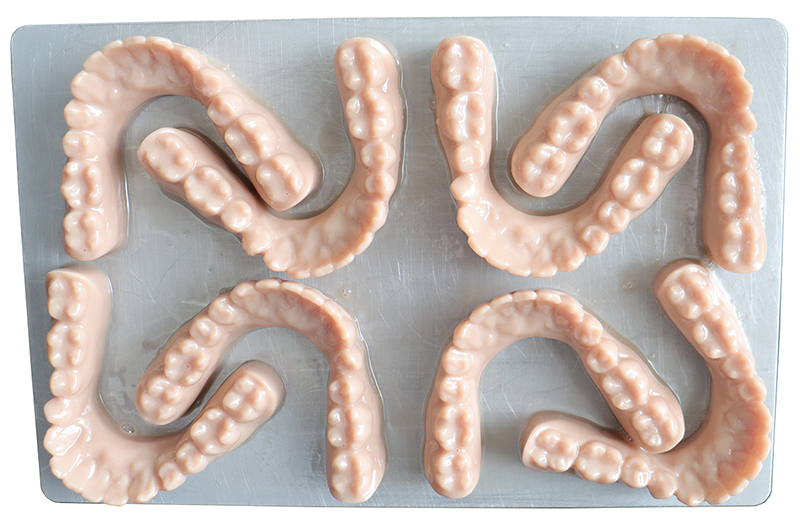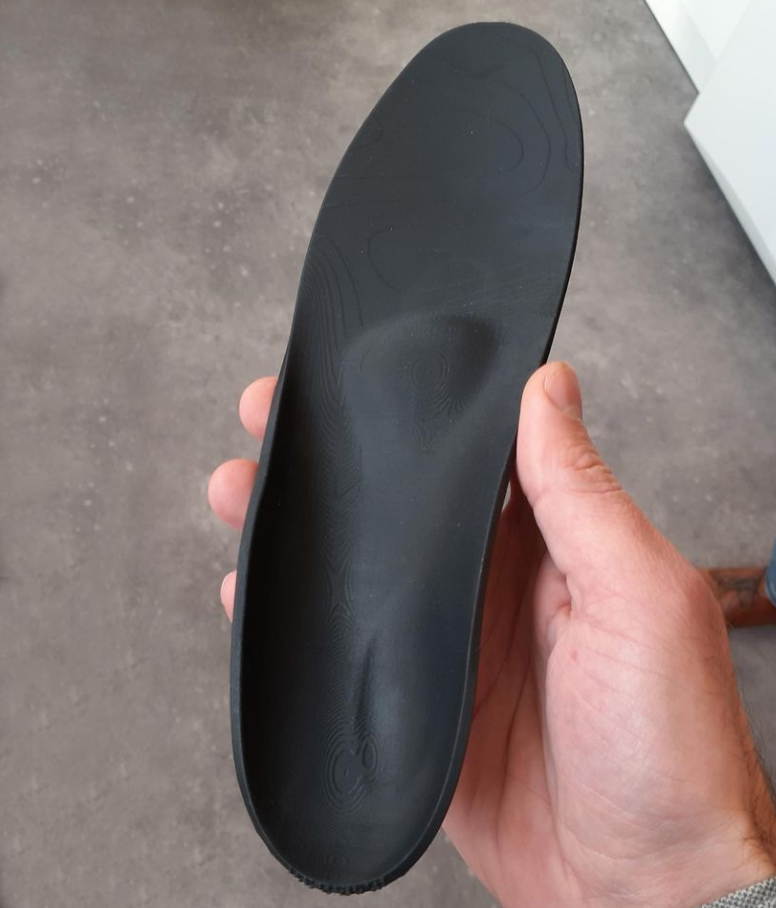3D-printing can be a lengthy process as most 3D-printing techniques focus on part quality rather than print speed. For resin 3D-printing, this is not much different. There are some new production grade techniques like 3DSystems Figure 4, Carbon3D DLS and EnvisionTEC / ETEC Envision One that use an oxygen permeable membrane to reduce peel forces and increase print speed significantly. For the other machines, there are still possibilities to increase the speed significantly by optimizing the print parameters that influence speed.

Image: Platform of dental aligner models 3D-printed with Liqcreate Premium Model resin at 0,1mm layer thickness in less than 20 minutes.
Why is the print speed in resin 3D-printing sometimes low?
The speed of resin 3D-printing is determined by a lot of factors. The resin itself needs an exposure time of a couple seconds. Followed by a wait time, time to lift the platform and time to retract. This all to get a perfect results. On all these settings, a little bit of time reduction times the amount of layers printed, can add up to a significant increase in print speed.
How can i speed up resin printing?
There are roughly 7 settings that influence 3D-printing speed. In this section we will focus on each parameter. These seven printing parameters will influence the print speed the most:
- 1) Choose a fast & rigid resin and fast 3d-printer
- 2) Layer thickness
- 3) Reduce amount of bottom layers
- 4) Reduce wait time
- 5) Reduce lift distance
- 6) Increase lift speed
- 7) Increase retraction speed
- 8) Choose a less-stick version of FEP film called PFA or nFEP
Choose a fast & rigid 3D-printing resin and fast 3d-printer
Fast resin 3D-printing starts with a fast 3D-printer and a fast resin. Select a printer with high output in the right wavelength. For entry model MSLA printers, this is likely a monochrome LCD 3D-printer with 405nm light source. Additionally, rigid resins print fastest and most stable as they form a stable rigid layer more quickly compared to tough or flexible materials. Next to the rigidity of the resin, also the reactivity is important. Choose a resin which is specially designed to for its high reactivity like the Liqcreate Premium range.
Layer thickness in resin 3D-printing
Often a layer thickness of 0,05mm is standard in resin based 3d-printing. For a lot of applications this is not needed. Accurate and detailed parts are also possible at a layer thickness of 0,1mm. This will reduce the printing time with almost half of the time. Only for dental, jewelry and other very accurate applications, the 0,05mm layer thickness will be beneficial and needed. For instance this insole 3D-printed with Liqcreate Tough-X on the Atum3D DLP station 5 was even printed at 0,15mm layer thickness to increase print speed and output.

Image: Insole 3D-printed with Liqcreate Tough-X on the Atum3D DLP station 5, printed at 0,15mm layer thickness to increase print speed and output.
Reduce amount of bottom layers
In standard settings, a lot of bottom layers are selected to increase the adhesion to the build plate. In practice, 1 or 2 layers are enough. So to reduce the bottom layers or burn-in layers to 1 or 2, a few minutes can be taken off the print time.
Reduce wait time
A bigger print time reduction can be achieved with reducing the waiting or movement time per layer. As this time will be calculated for each layer, it can reduce the print speed significantly. Wait times are often set as:
- – Rest time before lift
- – Rest time after lift
- – Rest time after retract
The rest time before lift does influence part quality. It is advised to keep a minimum of 0,5 seconds, and for some resins even more. Lift time after lift is only important for high viscous (thicker) resins. If your resin is quite liquid, then set it to 0 seconds. Rest time after retract is important for high viscous and tough/flexible resins. For rigid resins a minimum of 0,5 seconds is advised. Minimizing rest time can have a big influence on the total print time.
Reduce lift distance
A standard lift distance of 6 mm is often quite on the safe side. Usually 4-5mm is more than enough for small and medium printers. It is advised to look at your printer during printing and determine when the part is lifted from the FEP or silicon resin tank. If it is well before the end, then reduce your lift time to increase print speed.
Increase lift speed
The lift speed can be increased for rigid resins to gain speed. Often the weakest point in the part is where the support tips touch the part. If you increase the lift speed towards the maximum, it is advised to increase the tip size or amount of intersection with the model to prevent failures.
Increase retraction speed
A low retract speed is important for soft, tough and flexible resins to prevent movement of the parts when the platform moves back in position. For rigid and low viscous resins, the retract speed can often be improved without losing too much detail in your part.
We hope this was an educational read and you are able to increase the print speed of your resin 3D-printing process. Some settings should be changed carefully as they do improve speed, but also have an influence on part quality. If you have any questions or comments, feel free to send us an e-mail at info@liqcreate.com. In the meantime team Liqcreate wishes you happy printing.
Support
Do you need any help with 3D printing our SLA, DLP or LCD resins? We can help you! Just look for the question you have below. If you can’t find it, let us know by contacting us!


